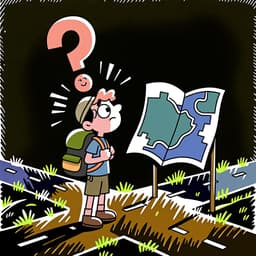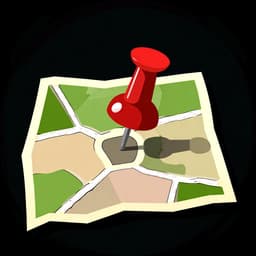How do I get to...?
in Spanish¿Cómo llego a...?
/KOH-moh YEH-goh ah.../
This is the most common, direct, and universally understood way to ask for directions. It literally translates to 'How do I arrive at...?' and is your go-to phrase in almost any situation.

Asking for directions with a simple phrase like '¿Cómo llego a...?' is a key skill for any traveler in a Spanish-speaking country.
💬Other Ways to Say It
¿Dónde está...?
/DOHN-deh ehs-TAH.../
This means 'Where is...?' and is often used interchangeably with '¿Cómo llego a...?'. It's slightly more focused on the location itself rather than the route, but people will understand you need directions.
¿Dónde queda...?
/DOHN-deh KEH-dah.../
A very common variation of '¿Dónde está...?' primarily used in Latin America. It means 'Where is... located?' and sounds very natural.
¿Cómo se llega a...?
/KOH-moh seh YEH-gah ah.../
This is an impersonal way to ask, like saying 'How does one get to...?'. It's very common and sounds slightly less direct than asking how 'I' get there.
¿Me podría decir cómo llegar a...?
/meh poh-DREE-ah deh-SEER KOH-moh yeh-GAR ah.../
This is a very polite and slightly more formal way to ask, meaning 'Could you tell me how to get to...?'.
¿Para llegar a..., por favor?
/PAH-rah yeh-GAR ah..., por fah-VOR/
A common and slightly more concise way of asking, literally 'To get to..., please?'. The question is implied by your tone.
¿Cómo hago para llegar a...?
/KOH-moh AH-goh PAH-rah yeh-GAR ah.../
This means 'How do I do to get to...?' It's a slightly more casual, conversational way to ask for directions.
¿Por dónde se va a...?
/por DOHN-deh seh vah ah.../
This translates to 'Which way does one go to...?' or 'How do you go to...?'. It focuses more on the route or path.
🔑Key Words
📊Quick Comparison
Here's a quick comparison of the most common ways to ask for directions, helping you choose the best one for your situation.
| Phrase | Formality | Best For | Avoid When |
|---|---|---|---|
| ¿Cómo llego a...? | Neutral | Almost any situation; it's the most direct and universally understood phrase. | Never, this is always a safe bet. |
| ¿Dónde está...? | Neutral | A simple, quick way to ask for a location. Just as common as '¿Cómo llego?'. | Never, this is also a very safe and common option. |
| ¿Me podría decir...? | Formal | Showing extra respect to elders, officials, or in formal settings. | It might sound a bit too formal when asking a friend or someone your own age. |
| ¿Para llegar a...? | Neutral | Sounding like a local in Spain, where it's very common and concise. | It's less common in Latin America, where '¿Cómo llego?' is preferred. |
📈Difficulty Level
Fairly easy. The main challenge for English speakers might be the 'll' in 'llego,' which can sound like an English 'y' or 'j' depending on the region.
Extremely simple for the asker. It's a fixed phrase where you just add the name of the place at the end. You don't need to worry about verb changes.
The nuance is low. The main thing is to remember to be polite by starting with 'Disculpe' or 'Perdón'.
Key Challenges:
- Pronouncing 'llego' with a regional accent.
- Understanding the fast, spoken directions you get in response.
💡Examples in Action
Disculpe, ¿cómo llego al Museo del Prado?
Excuse me, how do I get to the Prado Museum?
Oye, Marta, ¿dónde queda la estación de metro más cercana?
Hey, Marta, where is the nearest metro station?
Buenas tardes, señor. ¿Me podría decir cómo llegar a la oficina de correos?
Good afternoon, sir. Could you tell me how to get to the post office?
Perdón, ¿para llegar a la Plaza Mayor?
Excuse me, to get to the Plaza Mayor?
🌍Cultural Context
Always Start with Politeness
Before asking for directions, it's customary to get someone's attention politely. Start with 'Disculpe' (Excuse me, more formal) or 'Perdón' (Pardon me, more common). Jumping straight into the question can be seen as a bit abrupt.
Hand Gestures are Part of the Language
Don't be surprised if the directions you receive are accompanied by a lot of hand gestures, pointing, and head nods. This is a very common and helpful part of communication in Spanish-speaking cultures. Pay attention to body language as much as the words.
People are Generally Happy to Help
In most Spanish-speaking countries, people are very friendly and willing to help a lost tourist. Even if they don't know the answer, they might try to find someone else who does. A smile and a polite tone will go a long way.
The Art of Vague Directions
You might hear phrases like 'todo recto' (straight ahead), 'por ahí' (over there), or 'al fondo' (at the end/in the back). These can sometimes feel vague, but they're very common. 'Ahora mismo' (right now) can mean 'soon' and 'a dos cuadras' (two blocks away) might mean three or four blocks. It's all part of the experience!
❌ Common Pitfalls
Using 'Ser' Instead of 'Estar' for Location
Mistake: "¿Dónde es el museo?"
Correction: ¿Dónde está el museo?
Literal Translation of 'Get'
Mistake: "¿Cómo consigo al banco?"
Correction: ¿Cómo llego al banco?
Confusing 'a' and 'en'
Mistake: "¿Cómo llego en la estación?"
Correction: ¿Cómo llego a la estación?
💡Pro Tips
Combine with 'Is it far?'
After asking how to get somewhere, a great follow-up question is '¿Está lejos de aquí?' (Is it far from here?). This helps you decide if you should walk, take a taxi, or use public transport.
Write It Down
Have the name and address of your destination written down on a piece of paper or on your phone. This helps overcome any pronunciation issues and ensures the person you're asking knows exactly where you want to go.
Learn the Directional Basics
To understand the answer, you'll need to know basic directional words. The most important are: 'a la derecha' (to the right), 'a la izquierda' (to the left), 'todo recto' (straight ahead), and 'la calle' (the street).
Always Say Thank You
Whether the person could help you or not, always end the interaction with a simple 'Gracias' or 'Muchas gracias'. It's a small gesture that shows appreciation for their time.
🗺️Regional Variations
Mexico
'¿Dónde queda...?' is extremely common and natural-sounding in Mexico. Directions often reference landmarks, shops, or even colorful buildings rather than just street names.
Spain
The phrase '¿Para llegar a...?' is very characteristic of Spain. You'll also hear 'todo recto' (straight ahead) very frequently. Using 'vosotros' forms might be part of the response you get.
Argentina & Uruguay
The 'sh' pronunciation is a dead giveaway of the Rioplatense accent. The use of 'vos' instead of 'tú' is standard, so you might hear responses like 'vos seguís derecho' (you go straight).
Caribbean (Cuba, Puerto Rico, Dominican Rep.)
Expect fast-paced, rhythmic speech. Directions might be given in a very animated way. The contraction 'pa'l' for 'para el' is very common in casual speech.
💬What Comes Next?
After they give you directions
Siga todo recto dos calles y luego gire a la derecha.
Continue straight for two streets and then turn right.
Perfecto, ¡muchas gracias!
Perfect, thank you very much!
They don't know the location
Lo siento, no soy de por aquí.
I'm sorry, I'm not from around here.
No se preocupe, gracias de todos modos.
Don't worry, thanks anyway.
They ask for clarification
¿A cuál museo se refiere?
Which museum are you referring to?
Al Museo Nacional de Antropología.
To the National Museum of Anthropology.
🧠Memory Tricks
This silly sentence links the sound of the Spanish phrase to its English meaning in a memorable way.
This associates the key verb with a positive feeling, making it easier to recall.
🔄How It Differs from English
In Spanish, it's very common to use the impersonal 'se' construction ('¿Cómo se llega?'), which translates to 'How does one get there?'. While grammatically possible in English, it sounds very formal or archaic, whereas in Spanish it's a completely normal, everyday alternative. Also, the line between asking 'How do I get to...?' and 'Where is...?' is much more blurred in Spanish; both are used almost interchangeably to request directions.
False Friends & Common Confusions:
Why it's different: The verb 'get' in English is incredibly versatile. It can mean 'arrive', 'obtain', 'become', etc. A direct translation using the Spanish verb for 'obtain' ('conseguir' or 'obtener') is a common error. Saying '¿Cómo consigo el museo?' sounds like you are trying to acquire ownership of the museum.
Use instead: Always use 'llegar' (to arrive) for directions: '¿Cómo llego al museo?'
🎯Your Learning Path
➡️ Learn Next:
Left, Right, Straight Ahead
Once you ask for directions, you need to understand the answer!
Excuse Me & Thank You
These are essential politeness phrases to use before you ask and after you get an answer.
Where is the bathroom?
This is another crucial 'where is...?' question for any traveler.
How much does it cost?
This expands your travel vocabulary to include shopping and transactions.
I don't understand
A vital phrase for when the directions you receive are too fast or complex.
✏️Test Your Knowledge
💡 Quick Quiz: How do I get to...?
Question 1 of 3
You want to ask an elderly woman for directions to the cathedral in a very polite way. Which phrase is best?
Frequently Asked Questions
What's the real difference between '¿Cómo llego a...?' and '¿Dónde está...?'
Functionally, they achieve the same goal: getting directions. Technically, '¿Cómo llego a...?' ('How do I arrive at...?') asks for the route, while '¿Dónde está...?' ('Where is...?') asks for the location. In practice, people use them interchangeably. If you're completely lost, '¿Cómo llego?' might be slightly better, but you can't go wrong with either.
Is it rude to just walk up to someone and ask for directions?
It can be considered a bit abrupt. It's much better to first get their attention politely. A simple 'Disculpe' (Excuse me) or 'Perdón' (Pardon me) before you ask your question makes the interaction much smoother and more polite.
How do I say 'to the' when the place is masculine, like a museum ('museo')?
This is a great question! In Spanish, when the preposition 'a' (to) is followed by the masculine article 'el' (the), they combine to form a single word: 'al'. So, you would say '¿Cómo llego al museo?', not 'a el museo'. For feminine nouns like 'la estación' (the station), they stay separate: 'a la estación'.
What if I don't understand the directions they give me?
Don't panic! This is very common. You can say 'Más despacio, por favor' ('Slower, please') or 'Lo siento, no entiendo' ('I'm sorry, I don't understand'). It's also helpful to ask them to point: '¿Puede señalar?' or to ask if they can show you on a map: '¿Puede mostrarme en el mapa?'
Is '¿Para llegar a...?' only used in Spain?
It is most strongly associated with and most frequently used in Spain. While people in Latin America would likely understand what you mean from the context, it would sound distinctly Spanish. In Latin America, you're better off sticking with '¿Cómo llego a...?' or '¿Dónde queda...?' to sound more natural.
Which is more common in Latin America: '¿Dónde está?' or '¿Dónde queda?'
Both are extremely common. '¿Dónde está?' is universal and understood everywhere. '¿Dónde queda?' is also very widespread throughout Latin America and can make you sound a little more like a local. You can use them interchangeably without any problem.
📚Continue Learning Spanish Phrases
Explore More Phrases in These Categories
Find similar phrases to expand your Spanish vocabulary:
Want to Learn More Spanish Phrases?
Browse our complete collection of Spanish phrases organized by situation, from basic greetings to advanced conversations. Perfect for travelers, students, and anyone learning Spanish.
View All Spanish Phrases →





